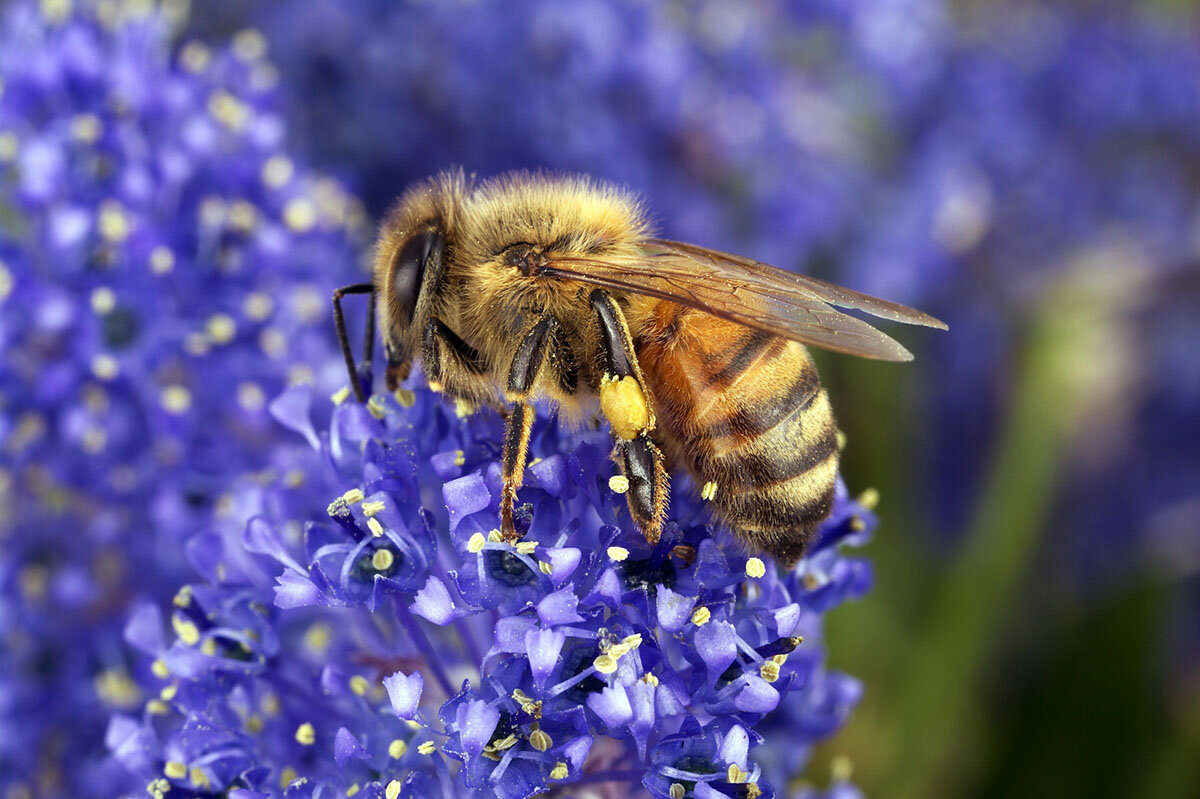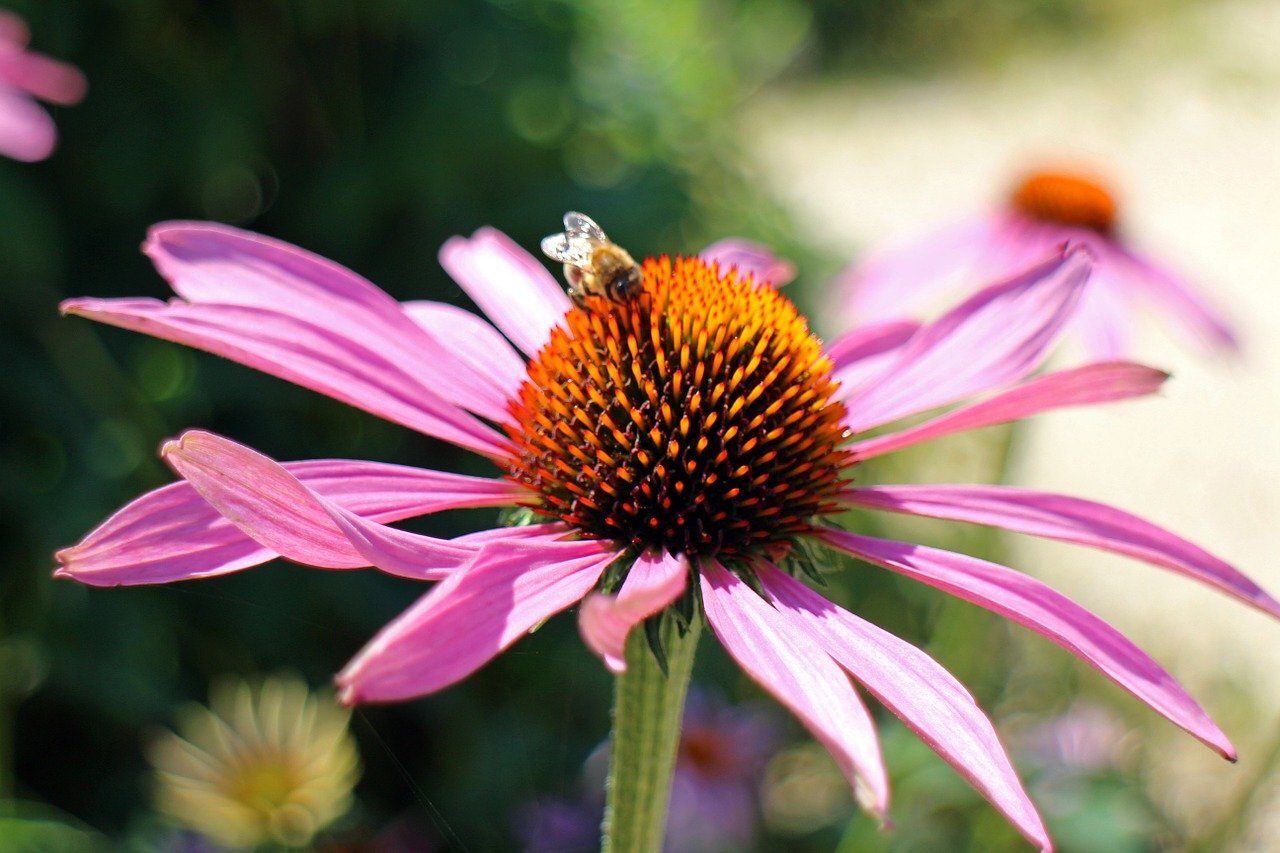What flowers do honeybees like?
Just like humans, healthy bees require a balanced diet. You may think bees have better access to food on farms than in the city but the truth is, bees that live in urban areas yield more honey than those in rural environments!
Why? Because many farms are monocultures: giant fields of one plant. On the other hand, cities have a larger variety of flowers.
If you want to support honeybees, creating a wildflower-rich garden with plenty for them to eat is one of the most impactful things you can do. In this article, we go through seven plants you can grow to support honeybees.
What do bees use pollen and nectar for?
When you see a bee on a flower, it’s not because it’s actively trying to pollinate the plant. That’s just a happy accident. What’s actually happening is that the bee—and its colony—are hungry!
Bees use pollen and nectar as food. Nectar provides them with carbohydrates, and pollen is their source of protein and fat.
Honeybees stuff pollen into baskets on their legs and use their tongues to suck up nectar. Think of this as them collecting raw ingredients. Back at the hive, the pollen and nectar are put into cells where it will be processed into honey and a substance called “bee bread” which they feed to their young.
Wait, but what about native pollinators?
Around 35% of crops rely to some extent on bees. That said, they’re far from being the only pollinators we should care about. In North Carolina alone, there are over 500 species of native bees. And that number doesn’t include other beneficial insects like butterflies and moths!
When you plant a garden full of native flowers, you help both honeybees and native pollinators. The more forage that’s available, the less these species have to compete.
The 7 best flowers to plant for bees
You wouldn’t want your favorite grocery store to only be open for one month of the year. In the same way, a good pollinator garden has flowers that bloom throughout the seasons. Some in spring, others in summer and fall.
Please note that our home state is North Carolina. In this guide, we selected plants that are native to our area, as they’re easier to maintain and provide forage for both honeybees and native pollinators.
If you’re in a different state, we encourage you to seek out other guides. The Xerces Society for Invertebrate Conservation has a helpful resource center that’s organized by location.
1. Bee balm (Monarda spp.)
This plant is called “bee balm” because it was once used to treat bee stings, but bees really are obsessed with the flowers. There are a variety of plants in the bee balm family that are native to North Carolina. Most are aromatic and have flowers that bloom for up to eight weeks.
Life Cycle: Perennial, biennial
Season: Spring
Light Requirement: Full sun, part sun
Soil Moisture: Dry, moist
Pack of 85 on Amazon for $6.99
2. White wild indigo (Baptisia alba)
White wild indigo grows two to four feet tall and can tolerate clay, gravel, and poor soil. This plant thrives with sun and occasional watering but can handle seasonal droughts or flooding. After the winter, it will go dormant until the following spring. In addition to bees, white wild indigo attracts frosted elfin butterflies and the block-spotted prominent moth. If you can’t find white wild indigo in particular, any wild indigo will do.
Life Cycle: Perennial
Season: Spring
Light Requirement: Full sun, part sun
Soil Moisture: Dry, Moist
3. Purple coneflower (Echinacea purpurea)
This beautiful perennial attracts honeybees, hummingbirds, and butterflies! It can be bought as a seedling at most garden stores. Be sure to water them until they become established. This plant can grow between two to five feet tall if you avoid planting it near other plants. (Competition for soil nutrients doesn’t let it reach its full potential.) Purple coneflower requires moisture and doesn’t do well in dry conditions.
Life Cycle: Perennial
Season: Late spring, summer
Light Requirement: Full sun, part sun
Soil Moisture: Moist
Pack of 100 on Amazon for $5.95
4. Black-eyed susan (Rudbeckia hirta)
For those of you still getting a hang of maintaining a garden, black-eyed susan requires very little care. It does okay in dry soil and mature plants are able to tolerate clay, rocky soil, heat, and drought. Just like the other plants on this list, it’s a great source of nectar for other native pollinators including the bordered patch butterfly.
Life Cycle: Annual
Season: Summer
Light Requirement: Full sun, part sun
Soil Moisture: Dry, moist
Pack of 100 on Amazon for $5.99
5. Joe-pye weed (Eutrochium purpureum)
As we move into the fall, bees need a source of nectar that lasts late into the season. That’s where joe-pye weed comes in. It’s extremely aromatic, meaning it’ll attract bees and plenty of other pollinators including hummingbird moths.
Life Cycle: Perennial
Season: Fall
Light Requirement: Full sun, part sun
Soil Moisture: Dry, moist
6. Marsh blazing star (Liatris spicata)
This striking native plant can take a few years to grow from seeds, but their eye-catching appearance is worth the wait. If this idea of starting from a seed intimidates you, there are a few online shops that sell the bulbs.
Life Cycle: Perennial
Season: Summer
Light Requirement: Full sun
Soil Moisture: Moist
7. Wrinkleleaf goldenrod (Solidago rugosa)
Similar to black-eyed susan, wrinkleleaf goldenrod is very hardy. It can thrive even in poor, dry soils. People often blame goldenrod for causing hay fever (aka seasonal allergies) but they’re mistaking it for ragweed which blooms at the same time.
Life Cycle: Perennial
Season: Late summer, fall
Light Requirement: Full sun, part sun
Soil Moisture: Dry, moist
Where can I buy these plants?
We added links to purchase the seeds on Amazon. Some of our recommendations, such as coneflowers, can be found at most garden centers. (Yes, even Lowes or Home Deport.) For the harder-to-find flowers, check out this list of plant supplies of the Chatham Mills Pollinator Paradise Demonstration Garden.
Do I have to grow native plants?
We favored native plants and perennials in this article. However, these can often be a little harder to find at traditional retailers. Don’t let this stop you from creating a garden. There are plenty of other easy-to-find plants that honeybees like: mint, lavender, basil, to name a few. The important thing is to get started and have fun! Any size garden helps.
Further resources
Even if you don’t have space for a beehive, planting a few of the flowers above goes a long way in helping bees
Congratulations on taking your first step toward creating a pollinator-friendly garden! It can feel overwhelming at first...there’s a lot of information out there! We promise once you get your first glimpse of a honeybee or butterfly drinking from a flower that you planted you’ll feel so excited. .
We hope this short guide was helpful. If you’d like more extensive information here are some of our favorite resources:








